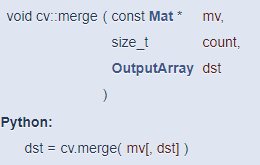在对图像做傅里叶变换的时候,看到了一段代码
Mat padded; //expand input image to optimal size int m = getOptimalDFTSize( I.rows ); int n = getOptimalDFTSize( I.cols ); // on the border add zero values copyMakeBorder(I, padded, 0, m - I.rows, 0, n - I.cols, BORDER_CONSTANT, Scalar::all(0)); Mat planes[] = {Mat_<float>(padded), Mat::zeros(padded.size(), CV_32F)}; Mat complexI; merge(planes, 2, complexI); // Add to the expanded another plane with zeros dft(complexI, complexI);在进行离散傅里叶变换(dft(complexI, complexI))之前,进行了merge操作
merge(planes, 2, complexI); // Add to the expanded another plane with zeros那么这一行究竟在干什么呢?
从形式上看,是将Mat数组中的两个单通道float类型的图像归并到一个Mat对象complexI中
得到的Mat对象complexI 便是一个两通道的图像了,且每个通道均为float类型(CV_32F)
1.解释
1.1 头文件
#include <opencv2/core.hpp>
1.2 函数原型

三个参数:
1.2.1 const Mat* mv
input array of matrices to be merged; all the matrices in mv must have the same size and the same depth.
这里使用了const ClassType * pointerName 的形式,即传入的Mat类型的指针不能修改这个图像本身的内容(但是可以用其他的方式修改),这里通常传入的是待合并的图像数组的首地址。传入的图像必须有相同的深度和大小。
1.2.2 size_t count
number of input matrices when mv is a plain C array; it must be greater than zero.
(参考博客:size_t 解释) 一个uint型的合并之后的图像的通道数,必须大于0
1.2.3 OutputArray
output array of the same size and the same depth as mv[0]; The number of channels will be equal to the parameter count.
dst 输出的图像数组(Mat对象或者其他类型),图像的最终channel与传入的size_t count相同,图像的尺寸与传入数组中的第一个单通道图像相同
1.3 功能解释
官网解释:Creates one multi-channel array out of several single-channel ones.
将多个单通道图像合并为一个多通道的图像
The function cv::merge merges several arrays to make a single multi-channel array. That is, each element of the output array will be a concatenation of the elements of the input arrays, where elements of i-th input array are treated as mv[i].channels()-element vectors.
merge函数是有序的,它将传入的单通道的图像按照次序进行串联,第i个输入的图像将被作为合并后图像的第i个通道
2.实例
Mat m1 = (Mat_<uchar>(2,2) << 1,4,7,10);
Mat m2 = (Mat_<uchar>(2,2) << 2,5,8,11);
Mat m3 = (Mat_<uchar>(2,2) << 3,6,9,12);
Mat channels[3] = {m1, m2, m3};
Mat m;
merge(channels, 3, m);
/*
m =
[ 1, 2, 3, 4, 5, 6;
7, 8, 9, 10, 11, 12]
m.channels() = 3
*/上面的代码生成了三个单通道的大小为2*2的Mat_对象
然后将这三个Mat_对象构成一个数组channels
使用函数merge将这三个图像合成一个三通道的图像m






















 1413
1413











 被折叠的 条评论
为什么被折叠?
被折叠的 条评论
为什么被折叠?








